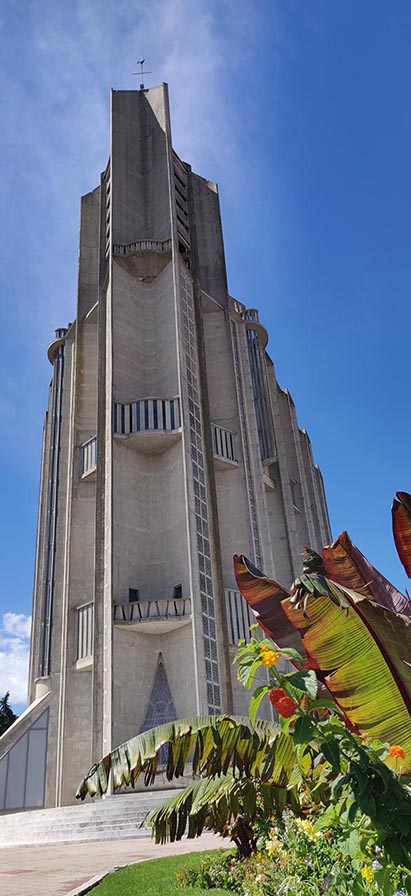Let's have a short tour in Notre-Dame de Royan
Notre-Dame de Royan is particularly known for its original shape and concrete design. Often decried by those who often do not even dare to push the door to discover the inside, it is a strong symbol of the Reconstruction of Royan, destroyed by the bombings of World War II. Here, the Liberation rhymes with major destruction. Royan is an exception in the "Reconstruction process" in France and will impose itself as a unique meeting place between architects and engineers, of which Notre-Dame is a masterpiece!
 Unlike what we often hear, Notre-Dame de Royan is not a cathedral but a church, even if its impressive dimensions tend to make us forget it! It is 45 meters long and 22 meters wide.
Unlike what we often hear, Notre-Dame de Royan is not a cathedral but a church, even if its impressive dimensions tend to make us forget it! It is 45 meters long and 22 meters wide.
Can we really remain unmoved in front of this immense bell tower which rises 60 meters high? Visible from far away, it stands out in the landscape like a lighthouse... From the beginning, the municipality wanted a very vertical project to symbolize a city still standing despite the atrocities of war!
The construction will take 5 years - Notre-Dame de Royan was inaugurated and blessed in July 1958.
Its design follows a slope. This is what will allow the staging of the building by taking care of this monumental staircase from which you can dominate the choir of the church. When you push the door, from the top of the staircase, it is just as if you were plunging into the nave.
Gilet was fond of medieval and particularly gothic architecture. If we observe, he knew how to transpose here all the symbolism found in a gothic cathedral. Take a look, even if the material changes, here concrete, concrete and more concrete... we find all the codes of a Gothic church: whether it is the search for light through the glazing or this form of mandorla adopted for the plan of the church.
It is true that the Latin cross plan is not present here, but in any case the mandorla, this elongated almond shape (of which I also talked about when mentionning the romanesque facade of Saint Pierre d'Angoulême), is a very old Christian symbol.
In terms of architectural innovations, I would like to emphasize the V-shaped concrete supports that can be seen both outside and inside. This is a real technical feat. Do you believe me if I tell you that the pillars are only 10 cm thick? They alternate with the large glass surfaces that let the light enter into the church.
I would also like to draw your attention to the so-called "saddle roof", whose vault is 35 meters high.
Thanks to technical advances and the association of Gilet the architect and Bernard Lafaille the engineer , the vault is only 6 cm thick! This has made possible to remove the interior pillars and design thinner supports. But still, a vault tends to spread the walls. To prevent the walls from spreading apart, in the past, we were used to built buttresses to push from the outside. The other solution adopted here is to use metal internal tie rods that you can see if you look up towards the vault.
Have a look to this video on my Youtube Channel Bordeaux Cognac Tour guide. This is in french but you can easily activate english subtitles that I have cerated !
I would also like to tell you a few words to make you look at the altar: also made of concrete of course but with an incredible lightness by adopting this kind of drapery!
A little word about the font on the right, wanted and designed by Gilet himself. It is in the shape of a fish, also a Christian symbol of the oldest.
 Finally, I will tell you not to miss the sculpture representing Joan of Arc that we owe to Jacques Perret. It is made of calcined metal. The material refers directly to the notion of martyred city. On its own, it represents both the Royan destroyed and the Royan rebuilt.
Finally, I will tell you not to miss the sculpture representing Joan of Arc that we owe to Jacques Perret. It is made of calcined metal. The material refers directly to the notion of martyred city. On its own, it represents both the Royan destroyed and the Royan rebuilt.
Note that the architect, Guillaume Gillet, considered Notre-Dame de Royan as his masterpiece. He is buried on the left aisle of the church under the gallery.
To see all of that in pictures, I let you watch the little video below
(Thousand aplologise but only in French right now)
and as usual, if you found this article interesting
and have learned something from it,
do not hesitate to share it on social networks and leave a little comment below.
Terms & Conditions
Report